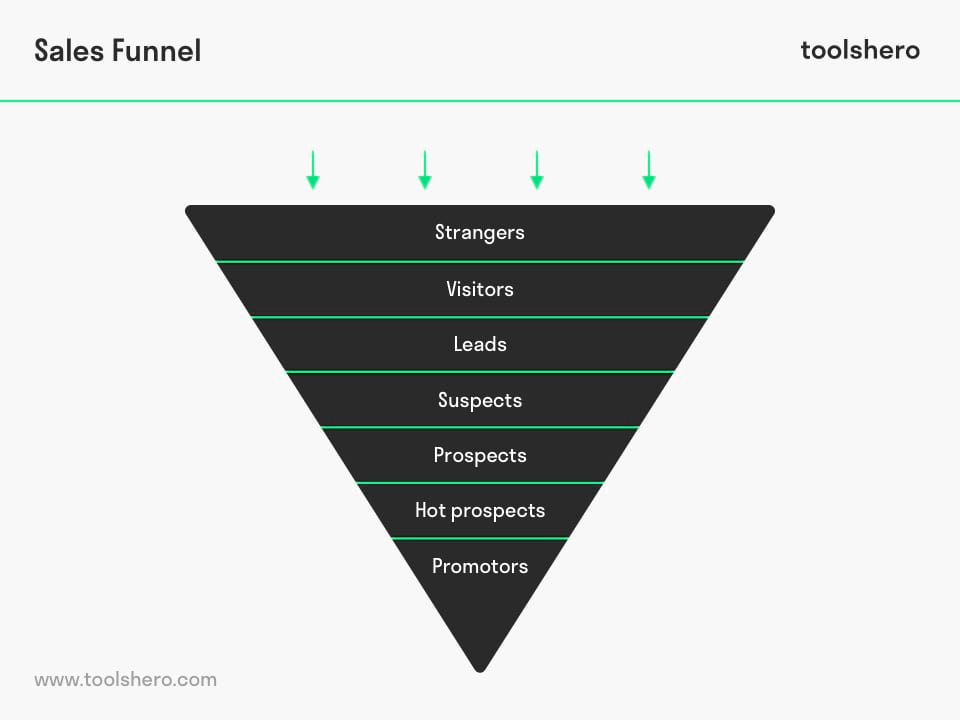Sales Funnel explained including the stages

Sales Funnel: this article explains the concept of the Sales Funnel in a practical way. The article starts with the definition of the sales funnel why it is an important tool for online marketing. You will find numerous tips and recommendations to improve your own sales funnel and how software can help you achieve this. Enjoy reading!
What is a Sales Funnel?
For any commercial organization, it is important to have and retain a good customer base. Nevertheless, it is also important to attract new customers.
A sales funnel is a visual representation of the steps a potential customer takes before making a purchase. It is a powerful tool that helps businesses understand the customer journey and optimize the sales process to increase conversions and revenue. The concept of a sales funnel has become increasingly popular in recent years, as businesses seek to better understand the buying behavior of their customers and improve their sales strategies.
The sales funnel typically consists of several stages, including awareness, interest, consideration, and decision, with the ultimate goal of driving the customer towards a purchase. By identifying where customers are dropping out of the funnel and optimizing each stage of the process, businesses can improve their sales performance and increase their bottom line. Whether you are a small business owner or a marketing professional, understanding the sales funnel is essential for success in today’s competitive marketplace.
Sales funnel and customer journey
The Sales Funnel is often used as an online marketing tool. It describes the process of how visitors become actual customers, also called the customer journey. Not every customer is aware of the products and/ or services a company offers.
The customer that is aware of the products and / or services a company offers will not necessarily purchase something immediately. A customer who is, for instance, looking for a company coffee machine will initially visit multiple locations, request information from various parties and ask for multiple quotes prior to ordering one from a single company.
The sales funnel shows the customer journey, as it were, which a customer makes prior to purchasing a product. It often starts with a first visit to a website.
Filling the sales funnel
Before the first layers of the sales funnel are described, we will first explain how to fill itl. The online marketing tool focuses on attracting customers via websites and social media. It is important for companies to realise that frequent publications help to attract online customers.
This means that a website must offer sufficient information with the option to submit requests via so-called Call-to-Actions (CTA) or by clicking. Free content offers, such as a white paper with specific information or an e-book, can provide lots of information about the client via specific software. Other publications such as blogs, newsletters and emails also attract customers.
Interaction with customers is also a great way to fill the sales funnel and to entice the visitor to become a customer. This can be accomplished by, for instance, giving webinars for which visitors need to register first and will subsequently be subscribed to the newsletter program. This is called ‘list building’. Encouraging customers to have a free, no obligation consultation or to request quotations are also ways to attract customers.
The stages of the sales funnel
The sales funnel is an upside down pyramid with leads at the top, who are not yet customers, and regular customers at the bottom who have already made purchases. By making the journey of the ‘suspect’ (potential customer) to ‘prospect’ (regular customer) insightful, sellers will exactly know how much time and energy they will need to invest to realise their monthly sales quota. The sales funnel terms will be further elaborated on below, each with a brief client characteristic:

Figure 1 – The Sales Funnel Stages
1. Strangers
The top of the sales funnel will be filled with many potential customers who are not yet familiar with the product or are not aware that a company produces a specific product. It concerns potential customers who are looking for a company coffee machine, though do not know which companies supply them.
2. Visitors
These are potential customers who are looking for information in a more specific manner. They will visit the website and read reviews, amongst others, on social media. This concerns people who are already familiar with the products and/or services and know where they can possibly purchase them.
In one way or another, they come into contact with the company, though are not yet ready to buy anything. By encouraging them to request information or to leave their details behind, they will automatically become leads which is the thorid stage of the sales funnel.
3. Lead
These are potential customers. This concerns potential customers who are familiar with the company and its products and are interested. They have actually subscribed to a newsletter, provided their contact details via a contact form, requested a free sample or quotation.
A company has put feelers out to this potential customer. It is crunch time. Doing nothing is not an option, though bombarding leads with information can be perceived as overly pushy. Therefore, leads must be handled with care.
4. Suspect
This is basically another name for a lead. However, the company has a slightly longer relationship with a suspect than with a lead, who for example, has only just subscribed to the newsletter. If after one year of vain attempts the suspect has still not made a purchase, you can stop trying and strike the suspect off your list.
5. Prospect
A prospect will place an order any time now. They can be persuaded by offering them a good deal. It is important to engage in an open dialogue with prospects and to ask what they thought of, for example, a sample. The so-called ‘foot-in-the-door’ technique can facilitate this. As soon as a prospect agrees to a small transaction, it will be difficult for them to turn down a nice offer.
6. Hot prospects
At this stage, the customer has become an actual customer, who has made a purchase. It is important that a company does not sit back, but instead continues to actively engage the customer. Now, customer satisfaction will start to play a role. Therefore, there is a significant chance that another purchase will be made or purchases will increase.
7. Promoters
These are repeat customers, who are happy with the product and service and share their experiences with their direct environment. Therefore, promoters give free publicity. The company has the opportunity to – and definitely should – build up a long-term relationship with them.
Optimizing the Sales Funnel
Optimizing the sales funnel in organizations is crucial for driving revenue growth and increasing customer satisfaction. Here are some tips on how to optimize the sales funnel:
Define your ideal customer
Understanding your target audience and their needs is essential for optimizing the sales funnel. This involves creating buyer personas and developing a customer journey map that outlines their touchpoints with your organization.
Personalize the customer experience
Tailoring the customer experience to meet individual needs and preferences can improve engagement and increase conversions. This can be achieved through personalized messaging, targeted offers, and customized content.
Streamline the sales process
Simplifying the sales process and removing any unnecessary steps can reduce friction and improve conversion rates. This can be done by providing clear calls-to-action, reducing form fields, and automating workflows.
Measure and analyze performance
Regularly monitoring and analyzing sales performance metrics can help to identify areas for improvement and make data-driven decisions. This involves tracking key performance indicators such as conversion rates, lead generation, and customer retention.
Continuously improve
The sales funnel is not a one-time event but an ongoing process that requires continuous improvement. This involves testing and experimenting with different strategies, analyzing results, and making changes accordingly.
By optimizing the sales funnel, organizations can improve customer acquisition, retention, and satisfaction, and ultimately drive revenue growth.
Pareto principle
The so-called Pareto principle applies to the sales funnel. According to this principle, introduced by the 20th century French-Italian economist Vilfredo Pareto, if 20% of energy is devoted to something, it will ultimately generate a result of 80%.
Likewise, if 80% of effort is put into something, it can ultimately only reap a result of 20%. This parallel also applies to large companies and their customer base. In most cases their biggest clients account for 20% of the total customer base. This group of regular customers is often responsible for 80% of the total company revenue, the so-called recurring revenues.
The same applies the other way round: small customers who make purchases from time to time, account for 80% of the total customer base.
However, their joint revenue does not generate more than 20% of the total revenue. It is therefore attractive for many companies to mainly focus on their regular customer groups. A classic mistake, as these customers may decide, for whatever reason, to purchase products or services from a different party.
Instead, especially among these small ‘sporadic customers’, there may be customers that will grow and increasingly purchase more products and/or services. This is where the Sales Funnel comes in. It’s is an online marketing tool that works like a funnel.
Not only the large regular customers are important, but particularly those tiny customers or customers that are still relatively unfamiliar with the product and/ or service of the organisation, can grow and make a fine contribution to the revenue.
Sales Funnel software applications
To gain proper insight into how the sales funnel exactly works, it would be smart for companies to use specific software applications that can measure the progress. This software can keep track of, amongst others, the number of visitors of your website.
Email marketing software can measure the number of leads and prospects. This kind of software keeps track of which people are on your mailing list, how many emails they have already received and whether they actually clicked on certain links. All this information is invaluable.
With analytics software, online shops can also measure how many purchases have been made and who the specific customers were. Landing page software can help to identify the visitors, how long they viewed the page and which parts were read most.
This way, the Sales Funnel analysis can indicate which customers are not interesting and which customers are on their way to becoming potential customers. Many visitors will not necessarily become customers immediately. The data from the sales funnel also shows whether or not visitors are aware of how to easily provide their contact details. All this this information can be applied to make adjustments to one’s website.
Sales Funnel summary
The sales funnel is a framework that outlines the stages a potential customer goes through before making a purchase. It starts at the top of the funnel with awareness and ends at the bottom of the funnel with a purchase. Understanding the sales funnel is critical for creating an effective sales process that aligns with the customer’s needs and expectations.
To build a sales funnel for your business, you need to understand your customer’s journey and create a strategy that guides them through each stage of the funnel. This involves mapping out the sales cycle and identifying the key touchpoints where sales teams can engage with potential customers.
One key aspect of building a sales funnel is creating social proof, which involves leveraging customer testimonials, case studies, and other forms of evidence to demonstrate the value of your product or service.
To optimize the sales funnel, it is important to focus on the customer experience and ensure that it is positive and engaging at each stage. This involves providing excellent customer service, personalizing communication, and responding to customer feedback.
Overall, the sales funnel is a crucial tool for sales and marketing teams to understand the customer journey, optimize the sales process, and drive revenue growth. By creating an effective sales funnel that aligns with customer needs and expectations, businesses can improve customer acquisition, retention, and satisfaction.
It’s Your Turn
What do you think? Have you ever heard of a Sales Funnel? Do you recognize the practical explanation or do you have more suggestions? What are your success factors for getting a grip on your online product sales conversion?
Share your experience and knowledge in the comments box below.
More information
- Cai, S. Q., Yu, Y. P., & Wang, Q. G. (2005). Research on Sales Funnel Model that Supporting Customer Identification and Retain [J]. Chinese Journal of Management Science, 2, 012.
- Heiman, S. E., Sanchez, D., & Tuleja, T. (1998). The new strategic selling. Nightingale-Conant Corporation.
- Patterson, L. (2007). Marketing and sales alignment for improved effectiveness. Journal of digital asset management, 3(4), 185-189.
How to cite this article:
Mulder, P. (2018). Sales Funnel. Retrieved [insert date] from Toolshero: https://www.toolshero.com/marketing/sales-funnel/
Original publication date: 10/02/2018 | Last update: 05/22/2023
Add a link to this page on your website:
<a href=”https://www.toolshero.com/marketing/sales-funnel/”>Toolshero: Sales Funnel</a>













One response to “Sales Funnel explained including the stages”
Hello dear, I am Melisa Smith. I am very glad to read your top notch article. I try to read different types of digital marketing related articles daily. Today I am surfing to read about “Sales Funnel” and I found your very well written precious article. I got and learned some new concepts and lessons from your content. I believe it will help me a lot. Thank you so much for your impressive article. I appreciate your effort to write such worthy content. The information shows that you are knowledgeable about this subject and is helpful for the newbie and the for the expert alike.